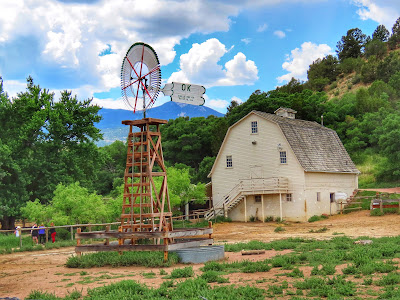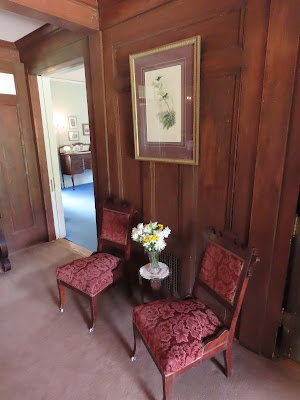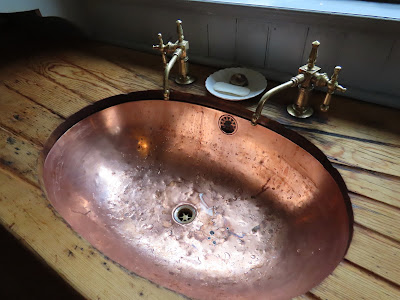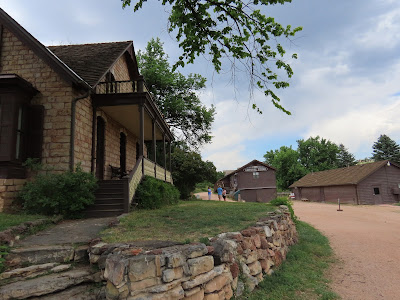After touring the Garden of the Gods Alesia and I made the short drive to the Rock Ledge Ranch Historic Site. It is part of Garden of the Gods park, located in its southeast corner.
The ranch is an interesting complement to the massive red rocks of “GOTG.” Here visitors are immersed in the lifestyles and homes of the Pikes Peak region's early inhabitants.
The first American settlers built modest dwellings like this.
A surprise upon entering the log cabin is finding these young ladies ready to tell you about what life was like back in the 1860s when the Galloway family made their homestead here.
Dressed in period clothing these historical interpreters not only tell you what life was like but they can show you too by demonstrating cooking, washing clothes…
…and milking the family cow (well not sure if they actually milk Ol’ Betsy but I’m sure the girls could tell people how it was done).
The family had to be self-reliant in almost all aspects of early life out West.
In 1862 President Abraham Lincoln signed into law the Homestead Act that offered land at low prices to Americans willing to move to wild undeveloped territories such as Colorado.
One seeker of a new life was 37-year-old Walter Galloway, an immigrant from Scotland, who in 1867 made his way to Colorado Springs. He built this cabin and presumably, this is his portrait on the mantle.
Galloway was described in 1885 in the following way by a woman who lived in the area: “ Mr. Galloway was a plain, plodding day laborer but exemplified what persistence can do in securing a home in his own name by staying in one place and cultivating the regulation patch of garden demanded by Uncle Sam, while earning the greater part of his living by day’s labor wherever it could be secured.” In 1874, Galloway sold his 160-acres for $1,400 to a Pennsylvania man, Robert Chambers, who moved out West to try to improve his wife’s health.
The Rock Ledge Ranch walking tour begins with a few Ute Indian displays. This part of Colorado was home to the Utes for centuries before Americans ventured here en masse.
There were no interpreters or displays in this area so not much information could be gleaned.
But at this structure was something that definitely got my interest and blood going.
See my post showing the many Colorado and New Mexico birds and animals I photographed during our 10-day trip.
Minutes after the Spotted Towhee, I played peekaboo with this tiny House Wren. It has a solid nesting spot in a hole in this tree.
The ranch has an array of interactive elements. You can watch, speak with the ranch "hands" and even join in on activities such as helping tend to the farm, and assisting the blacksmith make a horseshoe perhaps.
This is the Orchard House, circa 1907. The architecture is the Cape Dutch or South African Colonial style. This was appropriate given the home was commissioned by the founder of Colorado Springs, Gen. William Jackson Palmer, for his sister-in-law Charlotte and her husband William Sclater who were living in Cape Town, South Africa. Palmer, per the above link, was a Quaker who became a Union general during the Civil War and received the Medal of Honor for bravery in a battle in Alabama in 1865.
What a treat it was for us (just the two of us) to receive a tour of the grand old house. It is much larger inside than you might think.
Our guide provided a good overview about the house, its furnishings and what William and Charlotte Sclater were like.
William Sclater (1863-1944) published a book about the birds of Colorado. I liked this display of birds that must have been in his book.
We learned a slice of life in the Victorian Age, especially high society, was how visitors would drop off their calling cards.
A significant section of the home was for the servants. This room is where two of the women would sleep and work.
This is the dressing room where the lady of the house would get ready for her day or evening, often with the help of a servant.
A different guide showed us the kitchen and pantry. And it’s not just for show. The massive cast iron stove works and meals for the ranch staff are prepared daily. I’ve seen old stoves like this one on antique shows and a few displayed at restaurants.
We didn’t see everything there was to see at the Rock Ledge Ranch Historic Site. Rain was threatening and I was a little tired after the Garden of the Gods visit (link is to my recent post).
It is an interesting place that has so much to offer visitors It is especially educational for children.












































No comments:
Post a Comment